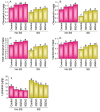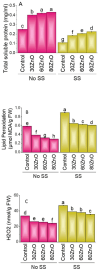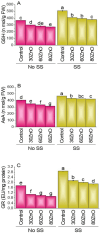Sargassum-synthesized ZnO nanoparticles induce salt tolerance in maize plants through enhanced physiological and biochemical mechanisms
- PMID: 40836076
- PMCID: PMC12368098
- DOI: 10.1038/s41598-025-16397-4
Sargassum-synthesized ZnO nanoparticles induce salt tolerance in maize plants through enhanced physiological and biochemical mechanisms
Abstract
Salinity is one of the biggest limitations of agriculture in semi-arid regions of the world. It negatively impacts the growth and yield of Zea mays L. Especially the seedling stage is extremely sensitive to salt stress. Sargassum tenerrimum J. Agardh. is a macroalgae which produces a plethora of important secondary metabolites, micro and macro-nutrients, polyamines and natural phytohormones etc. These compounds have been reported to improve plant growth and alleviate the harmful effects of salt stress. The current study explores the effectiveness of algal based Zinc Oxide nanoparticles (ZnOSt-NPs) in alleviating NaCl stress in Zea mays. The study involved two levels of NaCl (0 = control and 200 mmol kg- 1) and four levels (0, 30, 60 and 80 ppm) of ZnOSt-NPs applied through foliar spray. A notable enhancement was observed for morphological parameters Shoot length: 18.92%; root length: 18.56%; shoot fresh weight: 38.94%; dry weight: 23.74% and root fresh weight: 21.43% dry weight (27.97%) photosynthetic pigments (chl a: 40.98%; chl b: 93.55%; total chlorophyll: 55.38% and carotenoid 43.5%) and chlorophyll fluorescence parameters also exhibited a remarkable enhancement at 80 ppm ZNOSt-NPs under salt stress. Decrease in the levels of antioxidant enzymes (POD: 25.67%; SOD: 25.67%; CAT: 59.85% and APX: 54.21%) as well as non-enzymatic anti-oxidants (GSH: 34.67%; GR: 52.80%; AsA: 10.47% and lycopene: 34.40%) were also observed at 80 ppm ZnOSt-NPs under salt stress. The foliar application of ZnOSt-NPs significantly decreased MDA and H2O2 levels 38.40% and 32.80% and uptake of Na⁺ (34.25%) and Cl- (38.65%) respectively. while an increase in the total soluble proteins (87.50%), K+ uptake (77.27%), water content (74.63%) and salt tolerance index (17.12%) was observed with application of 80 ppm ZnOSt-NPs. This study provides important insight into the potential of algal based ZnO-NPs as a low cost and ecofriendly method for managing salinized soil.
© 2025. The Author(s).
Conflict of interest statement
Declarations. Competing interests: The authors declare no competing interests. Ethical approval and consent to participate: We declare that the manuscript reporting studies do not involve any human participants, human data or human tissues. So, it is not applicable. Our experiment follows the relevant institutional, national, and international guidelines and legislation.
Figures








Similar articles
-
Salinity stress amelioration through selenium and zinc oxide nanoparticles in rice.Sci Rep. 2025 Jul 29;15(1):27554. doi: 10.1038/s41598-025-12106-3. Sci Rep. 2025. PMID: 40731112 Free PMC article.
-
Enhancement of plant growth in lentil (Lens culinaris) under salinity stress by exogenous application or seed priming with salicylic acid and hydrogen peroxide.PLoS One. 2025 Jun 20;20(6):e0326093. doi: 10.1371/journal.pone.0326093. eCollection 2025. PLoS One. 2025. PMID: 40540484 Free PMC article.
-
Silicon oxide nanoparticles boost rice resilience to salinity by enhancing antioxidant defenses and stress regulation.Plant Sci. 2025 Oct;359:112588. doi: 10.1016/j.plantsci.2025.112588. Epub 2025 Jun 2. Plant Sci. 2025. PMID: 40466950
-
Promotion of Ca2+ Accumulation in Roots by Exogenous Brassinosteroids as a Key Mechanism for Their Enhancement of Plant Salt Tolerance: A Meta-Analysis and Systematic Review.Int J Mol Sci. 2023 Nov 9;24(22):16123. doi: 10.3390/ijms242216123. Int J Mol Sci. 2023. PMID: 38003311 Free PMC article.
-
Phytogenic nanoparticles: synthesis, characterization, and their roles in physiology and biochemistry of plants.Biometals. 2024 Feb;37(1):23-70. doi: 10.1007/s10534-023-00542-5. Epub 2023 Nov 2. Biometals. 2024. PMID: 37914858 Review.
References
-
- Parihar, M. & Rakshit, A. Arbuscular mycorrhiza: A versatile component for alleviation of salt stress. Nat. Environ. Pollution Technol.15, 417–428 (2016).
-
- Hussain, S. et al. Effects of salt stress on rice growth, development characteristics, and the regulating ways: A review. J. Integr. Agric.16, 2357–2374 (2017).
-
- Akram, S. et al. Exogenous glutathione modulates salinity tolerance of soybean [Glycine max (L.) Merrill] at Reproductive Stage. J. Plant. Growth Regul.36, 877–888 (2017).
-
- Kataria, S. & Verma, S. K. Salinity stress responses and adaptive mechanisms in major glycophytic crops: The story so far. in Salinity Responses and Tolerance in Plants, Volume 1: Targeting Sensory, Transport and Signaling Mechanisms (eds. Kumar, V., Wani, S. H., Suprasanna, P. & Tran, L. S. P.) vol. 1 1–39Springer, (2018).
MeSH terms
Substances
Grants and funding
LinkOut - more resources
Full Text Sources
Miscellaneous

